There are so many types of microgreens you can try growing, where do you even start? While you can grow mini-varieties of almost any vegetable, here are some of my favorites for you to try out.
Types of Microgreens to Grow
If you’re looking to start growing microgreens of new varieties, or just want to incorporate a few more into your diet, here are over 40 of my favorite types of microgreens.
Amaranth
- Family: Amaranthaceae
- Days to Harvest: 10-15 days
- Flavor: Nutty, yet sweet flavor
- Color: Red
- Pre-Soak: No
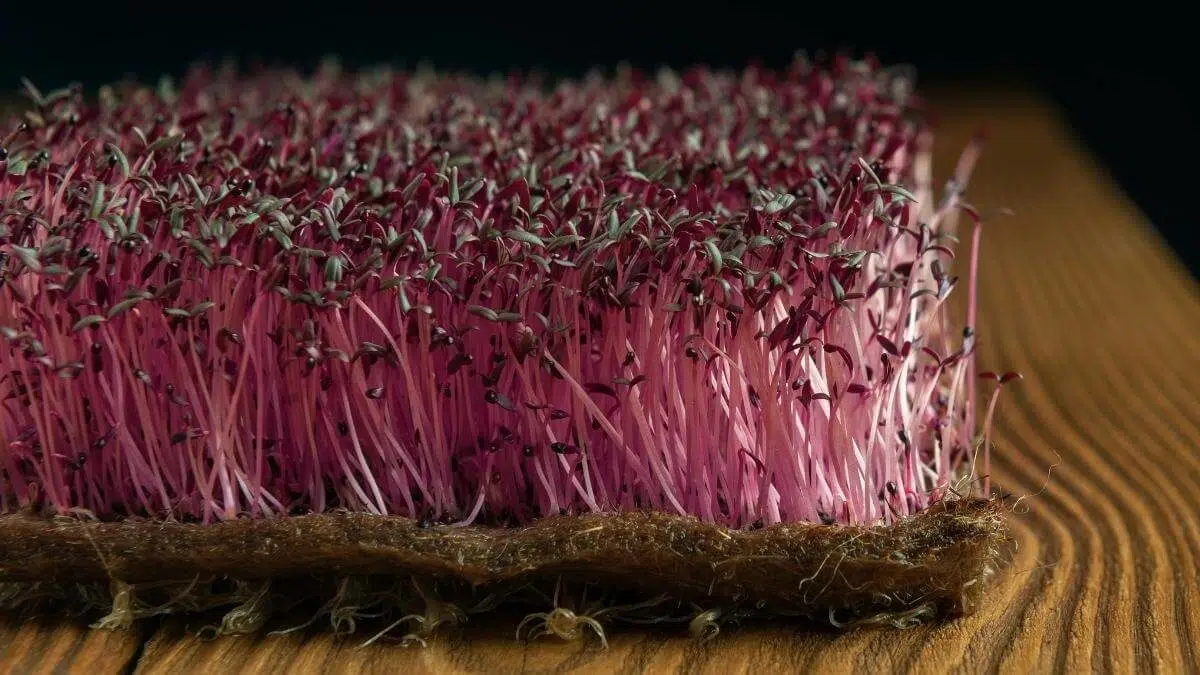
Amaranth microgreens have a slightly bitter, nutty, and sweet flavor. They appear in a variety of shades of red, ranging from light pink to deep burgundy.
These microgreens are one of the more popular types to grow because they’re pretty simple and add that beautiful deep pink/red color to your dishes.
Related Post: Amaranth Microgreens: Growing & What to Look Out For
Arugula
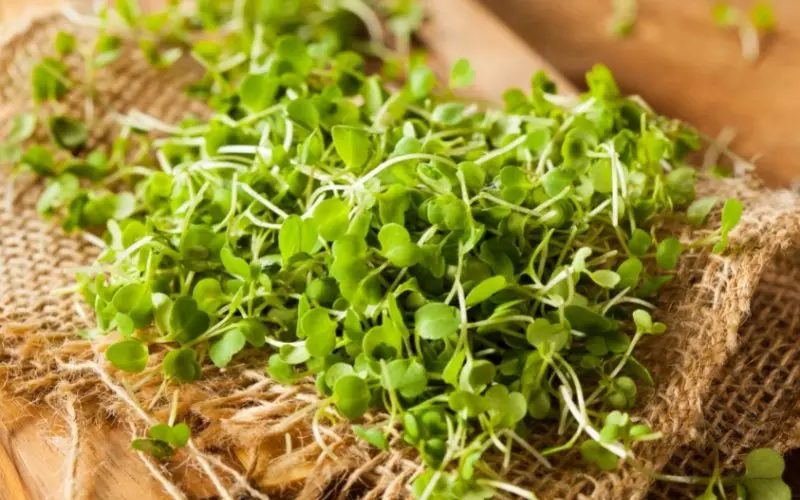
- Family: Brassicaceae
- Days to Harvest: 10-12 days
- Flavor: Spicy, pungent
- Color: Light green
- Pre-Soak: No
Barley
- Family: Poaceae
- Days to Harvest: 7-10 days
- Flavor: Grassy, earthy flavor
- Color: Green, White, Yellow
- Pre-Soak: Yes (12-24 hours)
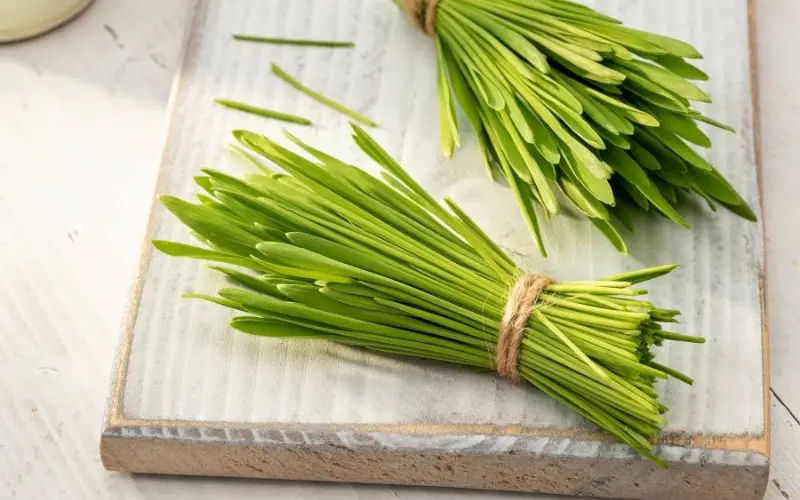
Barley microgreens have a nutty and sweet flavor. They grow almost in shoots rather than a typical microgreen with cotyledons.
Basil
- Family: Lamiaceae
- Days to Harvest: 10-12 days
- Flavor: A more mild basil flavor
- Color: Green or Purple depending on type of basil used
- Pre-Soak: No
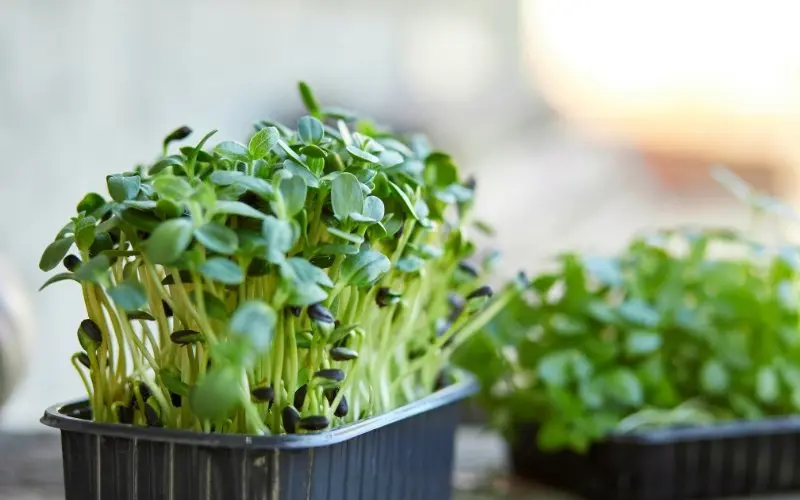
Basil microgreens have a similar flavor to mature basil, but a little sweeter and not as heavy on the anise flavor.
Micro basil has a pale to deep green color. You can also use opal basil or Red Rubin basil to grow microgreens and you’ll get beautiful purple microgreens instead of green ones.
Related Article: This article shows you how to grow basil microgreens.
Beans
- Family: Poaceae
- Days to Harvest: 12-14 days
- Flavor: Taste like beans, but a little muted.
- Color: Green, sometimes with red stems
- Pre-Soak: yes (12-24 hours)
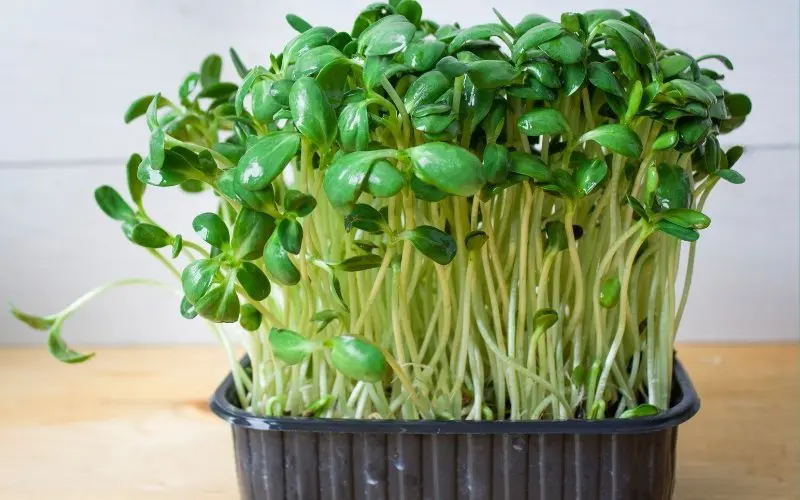
You can grow a variety of beans as microgreens, including mung beans, fava beans, and adzuki beans. Mung beans are often the beans used for a typical bean sprout you might find in the grocery store or at a restaurant.
The flavor is pretty cool because they taste like a bean you would expect, just a little milder.
Beet Microgreens
- Family: Amaranthaceae
- Days to Harvest: 8-12 days
- Flavor: Bitter and earthy with a sweet aftertaste
- Color: Green and red
- Pre-Soak: No
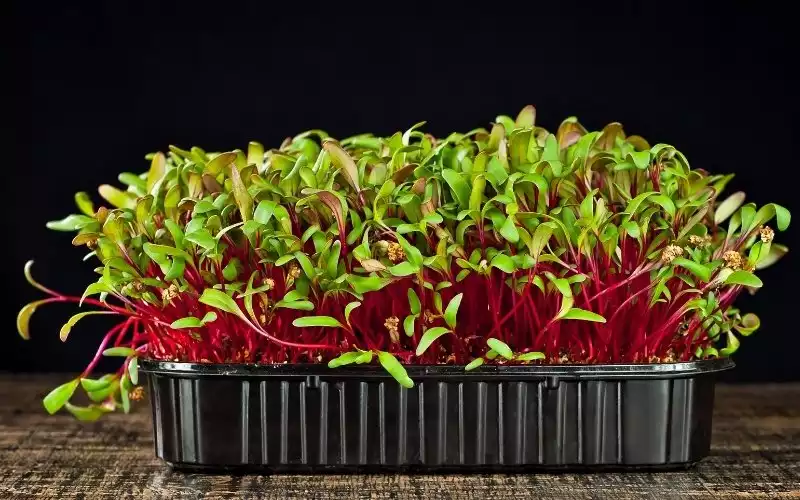
Beet microgreens have a sweet and earthy flavor. Their color can range from green to red depending on the types of beets used.
Bok Choy
- Family: Brassicaceae
- Days to Harvest: 10-12 days
- Flavor: Mild, earthy flavor
- Color: Green
- Pre-Soak: No
Bok Choy microgreens are in a wide variety of colors including yellow, white, and green. These are some of my favorites to grow because the tiny leaves are beautiful and have the veins of the mature plant.
Broccoli
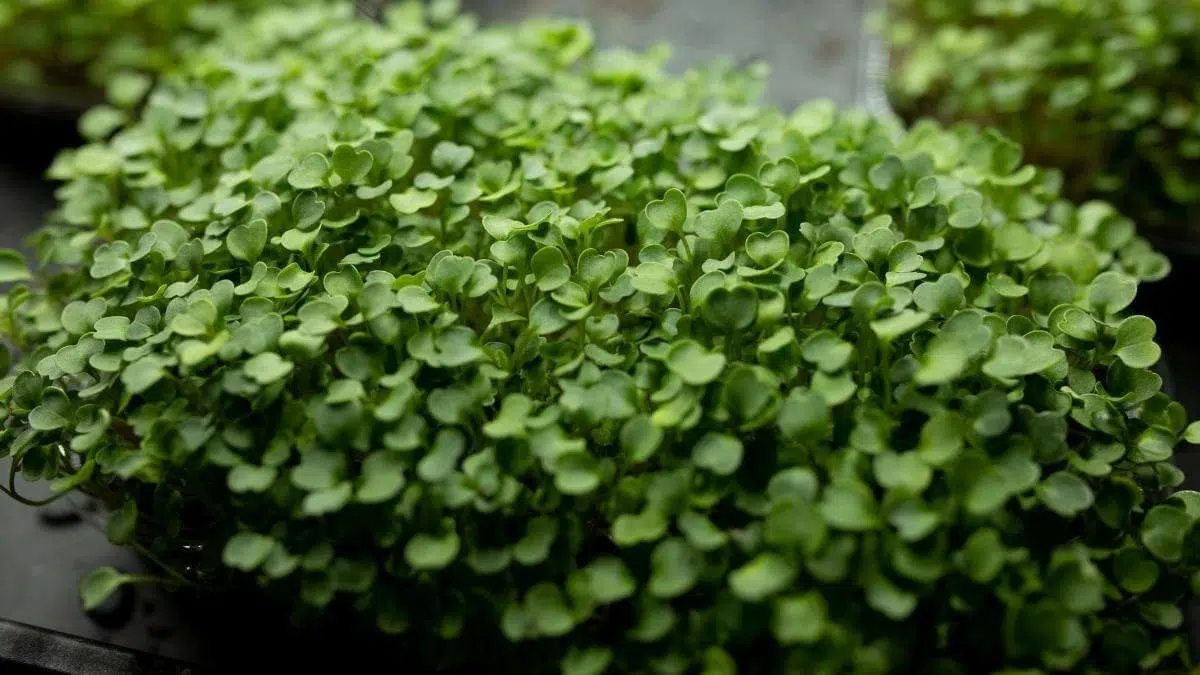
- Family: Brassicaceae
- Days to Harvest: 8-12 days
- Flavor: rich, nutty taste
- Color: Green
- Pre-Soak: No
One of the most common microgreens you’ll find being grown. Broccoli microgreens come in a variety of types including green and purple and have a rich, nutty taste.
Related Post: Broccoli Microgreens: Growing & What to Look Out For
Cabbage Microgreens
- Family: Brassicaceae
- Days to Harvest: 8-12 days
- Flavor: Mild, earthy
- Color: Red, green, or white depending on the cabbage variety
- Pre-Soak: No
Carrot Microgreens
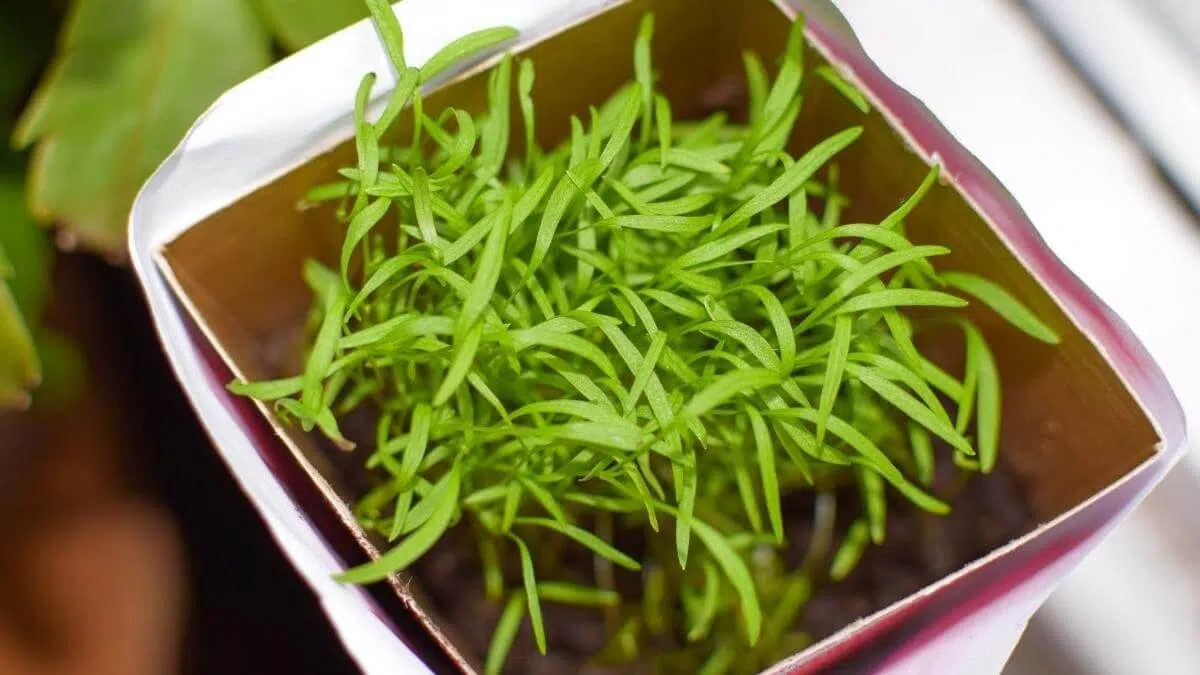
- Family: Apiaceae
- Days to Harvest: 18-25 days
- Flavor: Milder carrot flavor
- Color: pale yellow, green
- Pre-Soak: yes, but not required
Related article: How to grow carrot microgreens
Cauliflower
- Family: Brassicaceae
- Days to Harvest: 9-12 days
- Flavor: earthy and peppery
- Color: Dark green, with hints of purple
- Pre-Soak: No
Celery
- Family: Umbelliferae
- Days to Harvest: 9-12
- Flavor: Bubbly, sharp celery flavor
- Color: Light green
- Pre-Soak: Yes, around 18-24 hours
Chia
- Family: Lamiaceae
- Days to Harvest:
- Flavor: nutty, and slightly sweet flavor
- Color: Light green
- Pre-Soak: No
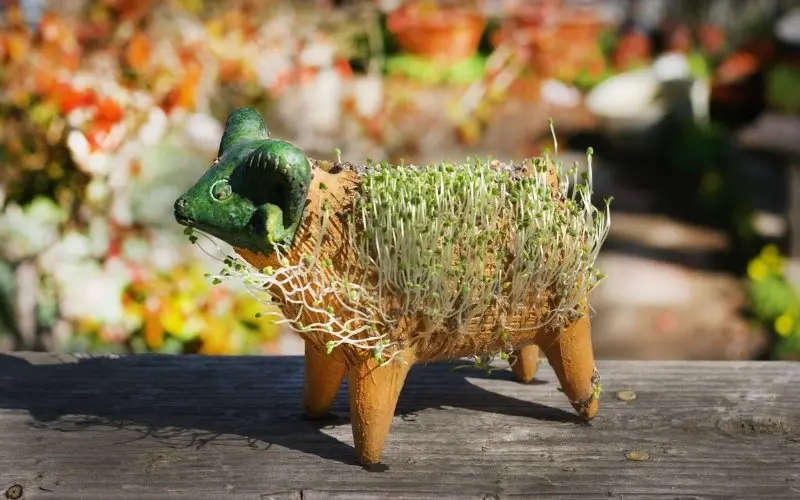
Cilantro
- Family: Apiaceae
- Days to Harvest: 9-15 days
- Flavor: Mild cilantro
- Color: Green
- Pre-Soak: No
Corn
- Family: Poaceae
- Days to Harvest: 6-7 days
- Flavor: Sweet corn flavor
- Color: Yellow/green
- Pre-Soak: 8-12 hours
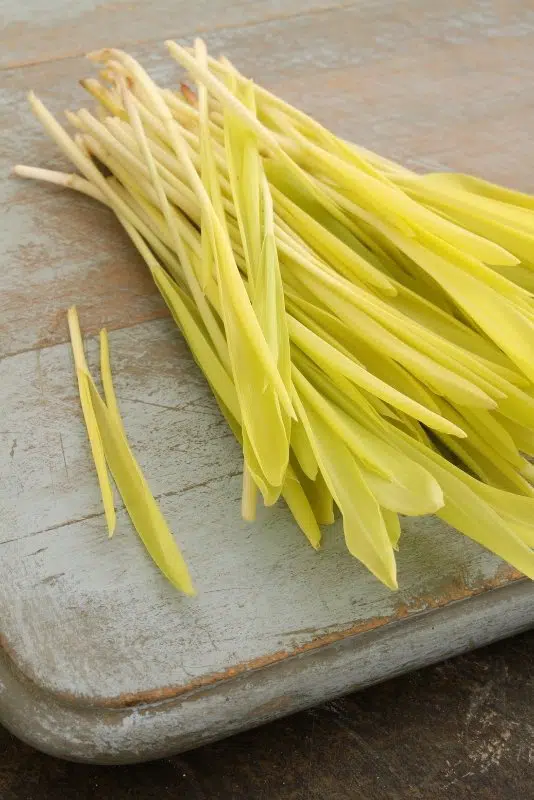
Corn shoots are notorious for being super quick growers, ready to harvest in about a week. These are one of the fastest-growing microgreens, as they’ll be ready in only 6-7 days.
They are also very unique in the sense that they are grown completely in the dark. Whoa…
If you’re interested, this is how you can grow corn shoots.
Cucumber
- Family: Cucurbitaceae
- Days to Harvest: 13-15 days
- Flavor: Herbal cucumber flavor
- Color: Green, broad leaves
- Pre-Soak: Yes
Cress
- Family: Brassicaceae
- Days to Harvest: 7-14 days
- Flavor: Sweet, peppery flavor
- Color: Green with white stems
- Pre-Soak: No
Dill
- Family: Apiaceae
- Days to Harvest: 13-15 days
- Flavor: Muted dill flavor, zest
- Color: Green with pink-white stems
- Pre-Soak: No
Endive
- Family: Cichorium
- Days to Harvest: 12-14 days
- Flavor: Slightly bitter flavor
- Color: Light green
- Pre-Soak: No
Fennel
- Family: Umbellifers
- Days to Harvest: 10-14 days
- Flavor: Mild anise
- Color: Green
- Pre-Soak: No
Kale Microgreens
- Family: Brassicaceae
- Days to Harvest: 8-10 days
- Flavor: Nutty, similar to mustard greens but not as spicy
- Color: Dark green leaves with pink and purple stems
- Pre-Soak: No
Leeks
- Family: Amaryllidaceae
- Days to Harvest: 10-12 days
- Flavor: Onion-y flavor
- Color: Green
- Pre-Soak: No
Lentils
- Family: Legume
- Days to Harvest: 10-13 days
- Flavor: Grassy, and crunchy
- Color: Dark Green
- Pre-Soak: Yes
Learn how to grow lentil microgreens here.
Lettuce
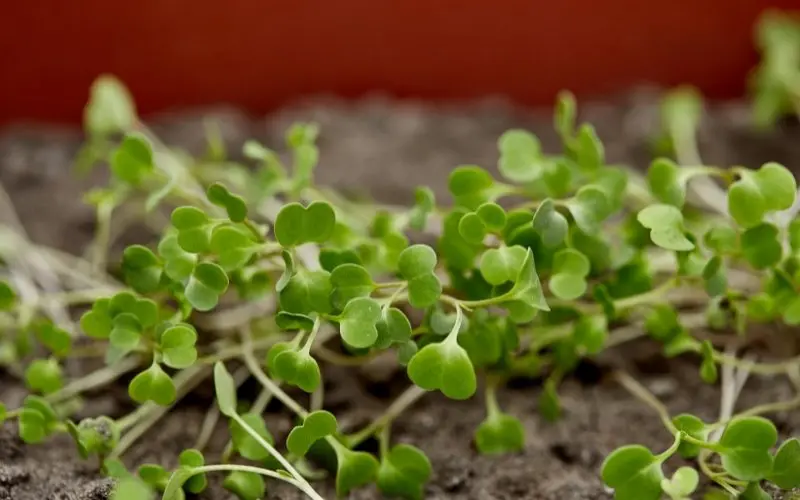
- Family: Asteraceae
- Days to Harvest: 8-13 days
- Flavor: Similar to regular lettuce, not a huge flavor boost
- Color: Light green
- Pre-Soak: No
Melon Micros
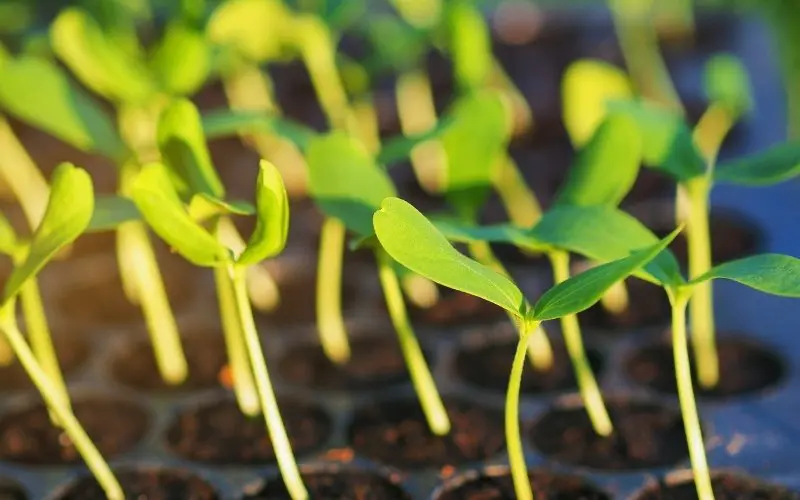
- Family: Cucurbits
- Days to Harvest: 8-10 days
- Flavor: Fresh melon flavor
- Color: Deep green
- Pre-Soak: Yes
Mint
- Family: Lamiaceae
- Days to Harvest: 7-14 days
- Flavor: Sweet, mild flavor
- Color: Green
- Pre-Soak: No
Mustard Greens
- Family: Brassicaceae
- Days to Harvest: 7-14 days
- Flavor: Spicy, mustard flavor
- Color: Pale green with white stems
- Pre-Soak: No
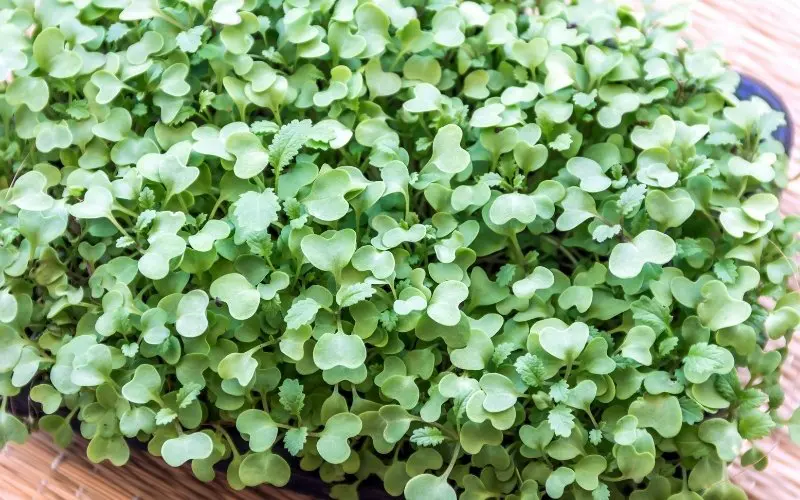
Oat Grass
- Family: Poaceae
- Days to Harvest: 7-10 days
- Flavor: Strong bitter taste
- Color: Green
- Pre-Soak: Yes
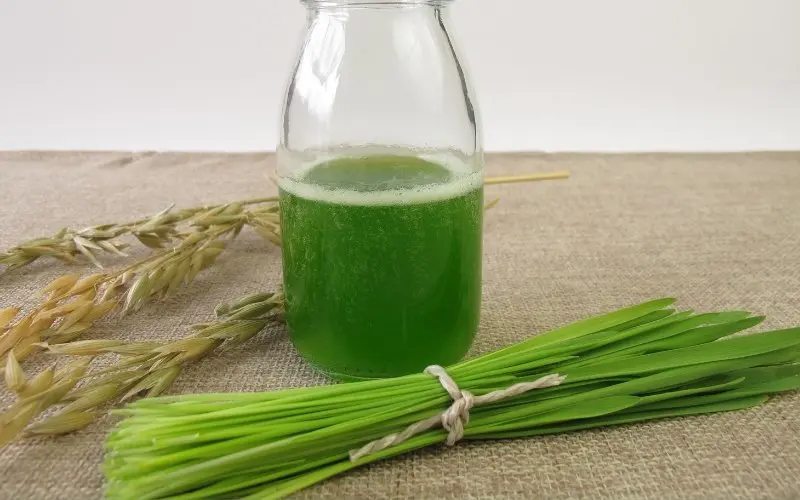
Onions
- Family:
- Days to Harvest: 14-21 days
- Flavor: Strong onion flavor with a hint of garlic
- Color: Green
- Pre-Soak: 2-6 hours
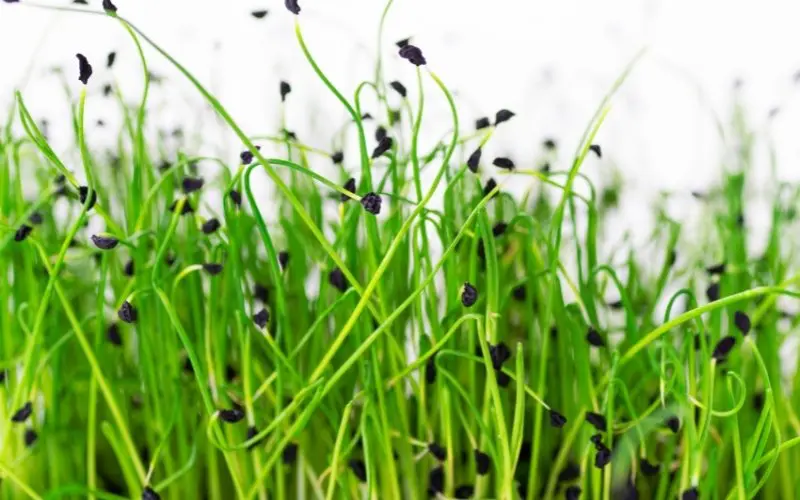
Onion microgreens are a great next step for intermediate or advanced microgreen growers. They’re not the easiest to grow, but they’re super versatile and can be a fun new one to try growing.
Oregano
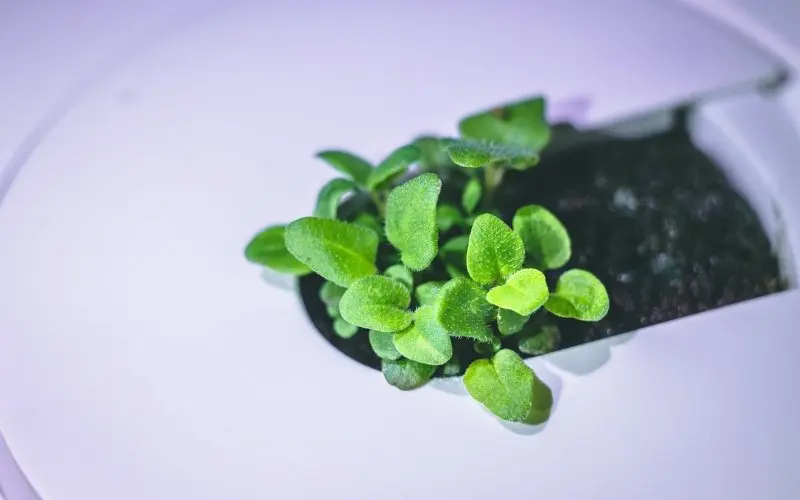
- Family:
- Days to Harvest:
- Flavor: Powerful, spicy flavor
- Color: Pale green leaves
- Pre-Soak:
Usually, microgreens have a more muted taste, but oregano is the opposite. Oregano microgreens often have a stronger flavor than mature oregano.
Pea Microgreens & Pea Shoots
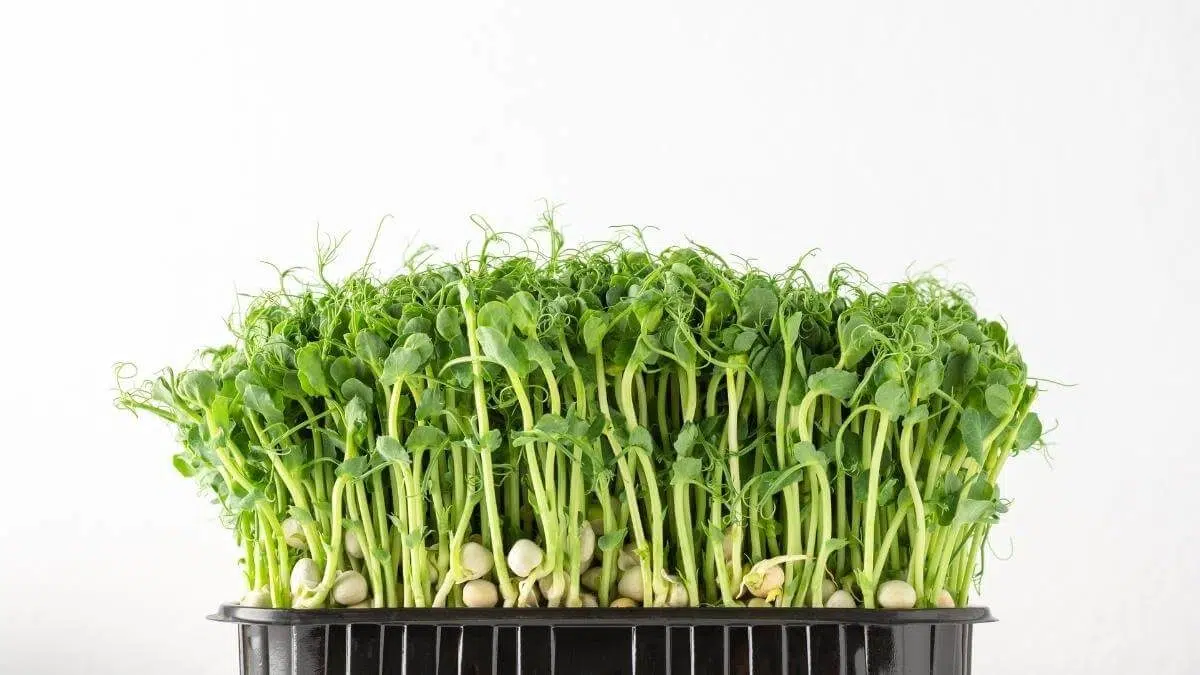
- Family: Fabaceae
- Days to Harvest: 8-12 days
- Flavor: Sweet, pea taste
- Color: Green
- Pre-Soak: Yes
Pea shoots are a popular type of microgreens – they’re crunchy with a sweet pea flavor, and they’re pretty easy to grow.
They can be grown from all types of peas, and they have cute tendrils coming off of them which makes them a little different from the “typical” microgreen.
Related: Pea Microgreens: How to Grow Them & Tips for Storage
Pumpkin
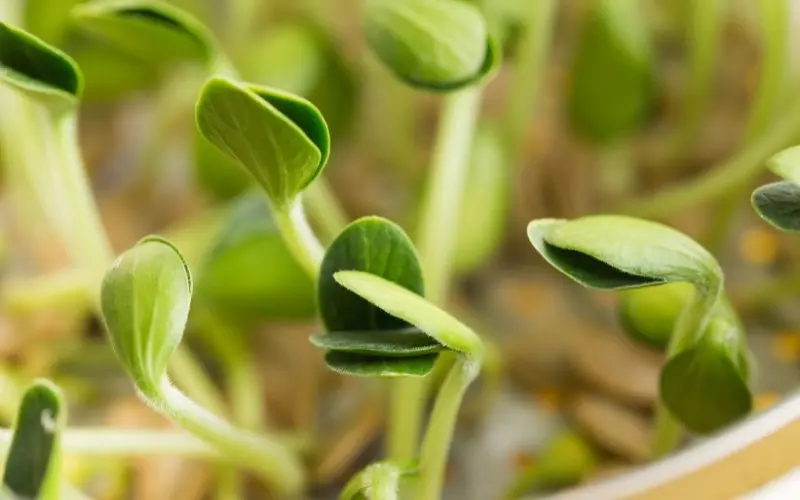
- Family: Cucurbitaceae
- Days to Harvest:
- Flavor: Sweet, but also bitter
- Color: Deep green
- Pre-Soak: Yes, 6-12 hours
Quinoa
- Family: Amaranthaceae
- Days to Harvest: 10-14 days
- Flavor: Mild, nutty flavor
- Color: Green
- Pre-Soak: Yes, 8-12 hours
Radish Microgreens
- Family: Brassicaceae
- Days to Harvest: 8-11 days
- Flavor: Earthy, a little spicy
- Color: Green or red depending on the type
- Pre-Soak: No
Related Post: Radish Microgreens: The Best Types & How to Grow Them
Sage
- Family: Lamiaceae (mint family)
- Days to Harvest: 14-21 days
- Flavor: Mild sage flavor
- Color: Deep green with pale green stems
- Pre-Soak: No
Related: 13 of the Best Types of Sage to Grow in Your Garden
Spinach Microgreens
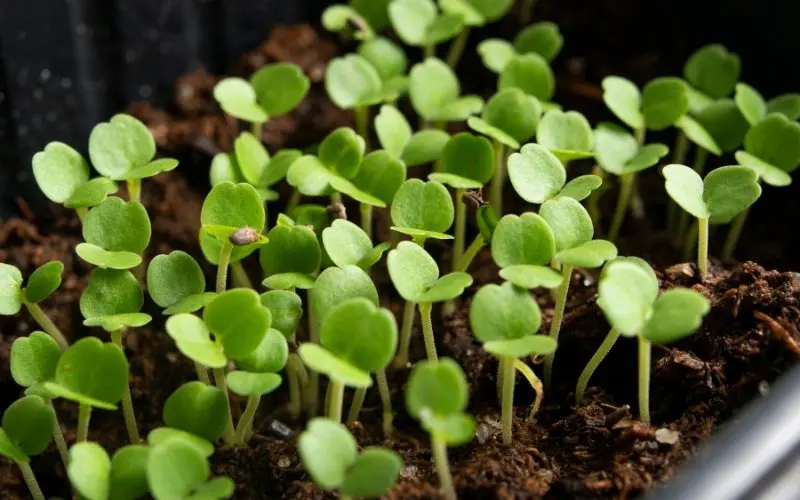
- Family: Amaranthaceae
- Days to Harvest: 10-13 days
- Flavor: Muted spinach taste
- Color: Green with pale, sometimes red stems
- Pre-Soak: No
Here is how you can get started growing spinach microgreens.
Sunflower
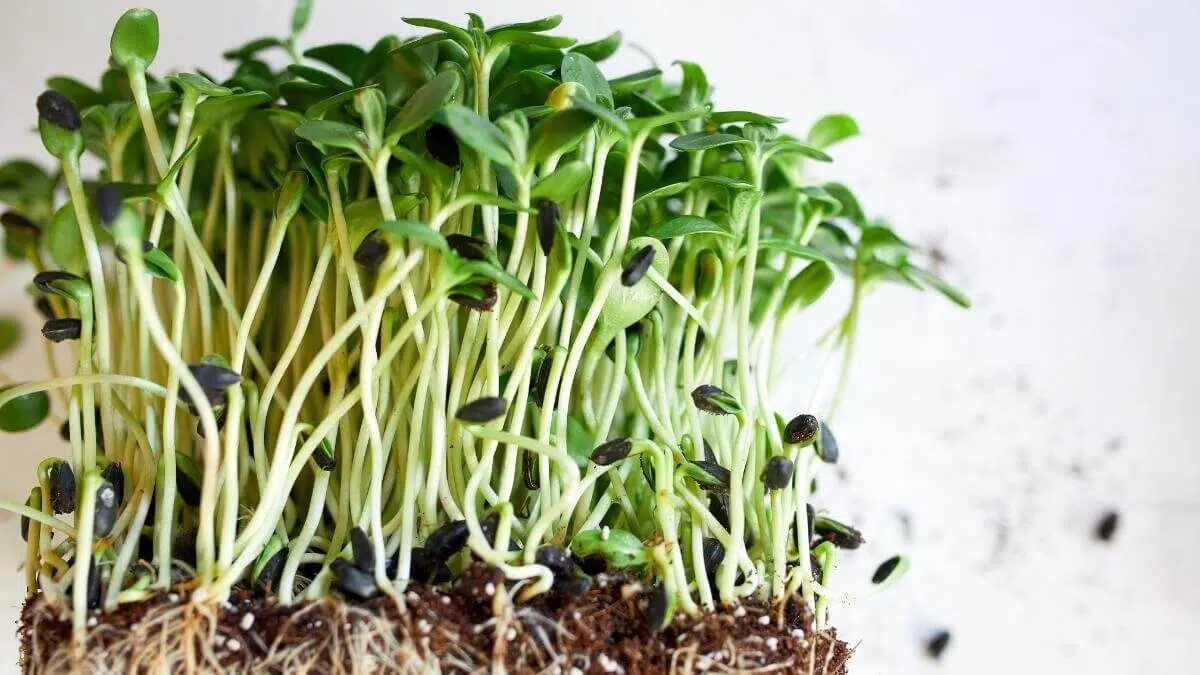
- Family: Asteraceae
- Days to Harvest: 9-12 days
- Flavor: slightly sweet, nutty flavor
- Color: Green leaves, pale stems
- Pre-Soak: 4-5 hours
Related Post: Sunflower Microgreens in Just 9 Days (High Yields!)
Swiss Chard
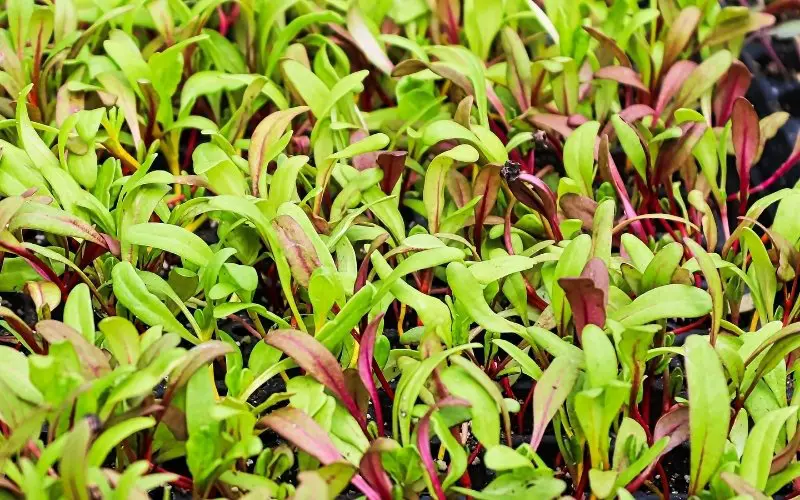
- Family: Amaranthaceae
- Days to Harvest: 10 days
- Flavor: bitter with an earthy aftertaste
- Color: dark red-maroon leaves and deep yellow stems.
- Pre-Soak: 4 hours
Learn how to grow swiss chard microgreens in this article.
Wheatgrass
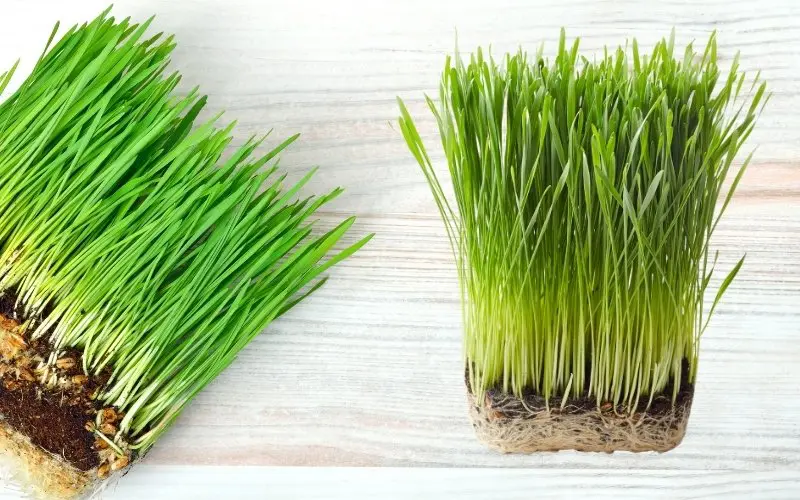
- Family: Poaceae
- Days to Harvest: 7-10 days
- Flavor: Grassy
- Color: Deep green
- Pre-Soak: No
Wheatgrass is what you’ll typically find as an optional add-on at a smoothie joint. It’ll give a smoothie that deep green color and pack it with nutrients.
Microgreens by Plant Families
There are many types of microgreens, here are some favorites categorized by family.
- Amaranthaceae family: amaranth, beets, chard, quinoa, and spinach
- Amaryllidaceae family: chives, garlic, leeks, onions
- Apiaceae family: carrot, celery, dill, fennel
- Asteraceae family: chicory, endive, lettuce, and radicchio
- Brassicaceae family: arugula, broccoli, cabbage, cauliflower, radish, and cress
- Cucurbitaceae family: cucumbers, melons, pumpkin, and squashes
- Lamiaceae family: herbs including mint, cilantro, basil, rosemary, sage, and oregano.
- Poaceae family: barley, corn, rice, oats, wheatgrass, legumes including lentils, mung beans, other beans, and chickpeas
Which Types of Microgreens Can You NOT Eat?
Nightshades should never be grown as microgreens. These leaves contain toxic compounds that will make you pretty sick.
These include plants like:
– Tomatoes
– Eggplants
– Potatoes
– Peppers
Do Microgreens Regrow After Cutting?
Microgreens don’t usually regrow after they are harvested. While some varieties will, it’s not worth it to try and regrow them, as you’ll be using up space you could be starting a new tray. Also, even if they did regrow, the nutrient content drops quite a bit on the subsequent growings.


